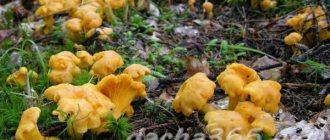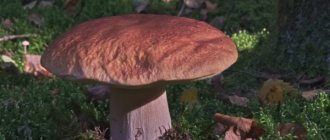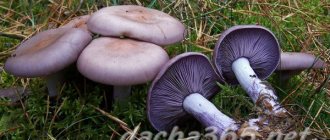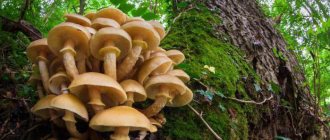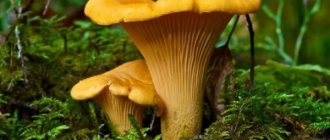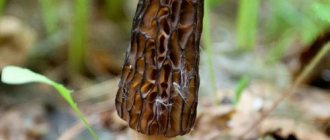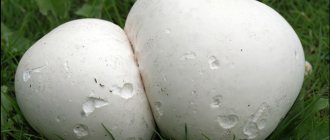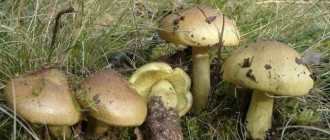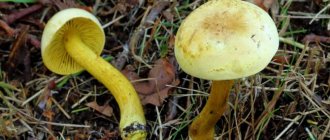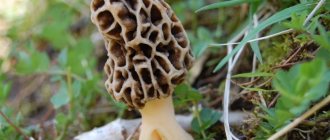Volnushki mushrooms, photos and descriptions of which are presented in this article, have distinctive features. Volnushki are similar to young milk mushrooms, but in color they are more similar to saffron milk caps. Many mushroom pickers underestimate this type of mushroom due to the fact that the fruits have a little bitterness, although their smell is quite pleasant, the main thing is to know how to cook them . This is because volushki are representatives of laticifers, the pulp of which contains thick juice, which appears when cut. It is this juice that has a burning and bitter taste.
Volnushki are conditionally edible, so before eating they must be well soaked and boiled in salted water.
Where do the waves grow?
You can find this type of mushroom almost everywhere where there are birch trees, especially in pure birch forests, although they also grow in mixed forests. This is due to the fact that mushrooms form mycorrhiza, the so-called fungal root, with wood. Moreover, they are mutually connected, like a mushroom with the tree on which it grows, and vice versa.
The first fruits appear in mid-summer, but if the weather is warm and humid, they may appear in early summer. The harvest lasts until October, because these mushrooms are not afraid of frost. They prefer to grow in large groups, so in the forest you often come across clearings dotted with pink caps. Most often they appear in open areas, but they also occur in thickets.
White representatives of this species prefer bright light and a lot of free space, so they are most often found at the edge of the forest.
Inexperienced mushroom pickers often find it difficult to figure out whether they have found a mushroom or a saffron milk cap.
Watch the video! How to distinguish volushki from saffron milk caps
Answers to common questions about waves
Where to look for wavefish? The favorite habitat of wavefish is the northern edges of the forest and birch groves. It is worth paying attention mainly to a well-lit open space with moist soil.
Why are they soaked? This is the only way to remove the bitterness from the milky juice that characterizes all types of this group. Most often, mushrooms are soaked for a day, changing the water several times. Some preservation methods require soaking for a longer period of time.
Is it possible to grow a wave at home? Yes, but it may take a long time. First you have to find suitable raw materials from which to obtain mycelium. After planting, mulching with straw, sawdust or fallen leaves must be carried out. It is recommended not to harvest the crop in the first year in order to get a more impressive result the next season.
Despite the peculiar taste of milky juice, volushki remain very tasty and healthy mushrooms. They are quite easy to distinguish from their inedible counterparts and can be prepared at home. If you follow the rules of collection and processing, you will be able to preserve all the natural properties of the mushroom.
Beneficial properties and dietary restrictions
These mushrooms contain a large amount of useful substances. Contains:
- 47% protein;
- 5% fat;
- 48% carbohydrates;
- cellulose;
- 22 kcal (per 100 g);
- minerals: magnesium, sodium, potassium, phosphorus, calcium;
- vitamins: ascorbic acid, carotene, group B, PP;
- lecithin;
- amino acids;
- antioxidants.
Thanks to this composition, eating trumpet mushrooms helps:
- normalize blood pressure;
- improve the functioning of the cardiovascular system;
- improve the condition of hair and skin;
- strengthen the immune system;
- reduce cholesterol levels;
- improve vision;
- cleanse the vessels.
There are limitations and contraindications:
- Cholecystitis;
- Pancreatitis;
- Gastritis with low acidity.
Pregnant women, breastfeeding women and children under 12 years of age should limit their intake of volushki.
Volushka mushrooms: benefits and harm to humans
In Europe, mushrooms are considered poisonous and harmful to the human body. It is believed that the toxic properties of these mushrooms can cause gastrointestinal upset. However, in other countries, for example, in Finland, this opinion regarding volushki is not shared, and they are boldly eaten.
In addition to its excellent taste, the mushroom mushroom can also boast of its usefulness. So, the benefits of waves:
This type of mushroom is very rich in protein, which cannot but attract attention to it. The chemical composition of the mushroom cannot but surprise. Here you will find various vitamins necessary for our body, and glucose with fructose, as well as folic acid and nicotinic acid that we need.
Agree, pretty good for such, at first glance, unsightly mushrooms. Let's move on to minerals, which we also really need for the normal functioning of the whole body. Calcium, potassium, magnesium, phosphorus - and this is not the whole list. Mushrooms have anti-inflammatory and antibacterial effects.
- Volnushki can significantly increase human immunity. Of course, we shouldn’t forget about the “healthy” amount of mushrooms consumed. The good thing is in moderation. If you decide that by eating a huge amount of mushrooms you will immediately become healthy, then your opinion will be wrong.
- Volnushki can improve human vision. Again, this means a slight improvement in vision and where possible. Mushrooms cannot perform a miracle.
- They perfectly restore the lost strength of the body.
- Thanks to its truly rich composition, it promotes hair and nail growth. Improves the condition of nails, hair and skin.
And now some interesting facts about mushrooms:
- Mushrooms are an excellent meat substitute. Just 150 g of mushrooms will easily provide your body with its daily requirement of protein.
- The mushroom cap contains a much larger amount of protein.
- This product is low-calorie, which means that it helps normalize metabolism and, accordingly, helps you lose weight.
- Due to the fact that mushrooms contain quite a lot of vitamin B, they are an excellent sedative.
- By regularly eating mushrooms, you can significantly improve the general condition of the body and increase immunity.
- In order for mushrooms to be better absorbed by your body, you need to cook them in sour cream or butter.
The harm and benefits of wave
Contraindications:
- Despite the fact that volnushki are very tasty mushrooms, not everyone can eat them and not always. First, of course, you need to exclude such mushrooms from the diet of young children. Most often, mushrooms are not given to children under 7-8 years of age. Also, pregnant women and women who are breastfeeding should not eat mushrooms.
- Now let's move on to diseases. Those who suffer from gastritis, cholecystitis, pancreatitis and other ailments of the gastrointestinal tract should refrain from eating this delicacy.
- They also convincingly insist that people without a gallbladder should not eat mushrooms either.
- Also remember that you cannot collect and eat old, overgrown, decrepit mushrooms. Since our volushki are classified as conditionally edible mushrooms, they must be soaked and boiled before use. The broth must be poured out; using it for food is strictly prohibited.
Types of waves
There are several subspecies of this mushroom, which can be distinguished by appearance, but their taste is almost the same.
- pink wave or Volzhanka;
- white wave or whitefish;
- yellow wave or wave;
- swamp wave or faded milkweed;
- gray volnushka, gray milkweed or serushka.
Most often there are two types of waves - pink and white.
Next, let's look at what volushka mushrooms look like.
Pink
Among its fellows, this variety stands out for its rather attractive appearance and large size.
- Young mushrooms have a convex cap, which becomes denser over time and a depression appears in the center.
- The edges are slightly pubescent, tucked underneath. When it rains, mucus appears on the cap and the mushroom becomes slippery.
- The pulp is white, sometimes with a slight pinkish tint. The structure of the mushroom itself is dense, so it can be transported and transported without crumbling.
- The size of the cap can reach 15 cm in diameter, and a pattern in the form of wavy rings is visible on it.
- The mushroom reaches a large size very quickly, in 3-4 days.
White
Another name for this mushroom is fluffy white mushroom. It is smaller than pink, and this is their difference .
- The cap is white with a cream tint, shaped like a funnel, without any patterns, and grows to 4-10 cm in diameter.
- The color of the depression in the center is slightly darker than the main one.
- The juice at the break is white and does not change color when in contact with air.
- The leg is strong at the beginning of growth, as it matures it becomes hollow.
- The color of the stem and cap are similar.
- Old specimens resemble milk mushrooms, become brittle, the edges are torn, and the color of the plates turns yellow.
Since representatives of this genus tend to secrete bitter and acrid juice, they must be soaked or boiled for a long time before cooking. And then the product can be salted or pickled for the winter .
What they look like
Volnushki belong to the genus of laticifers, the Russula family. These are lamellar, conditionally edible mushrooms, which must be thoroughly processed (soaked, boiled) before cooking. There are several types of wavefish: white (Lactárius pubéscens), pink (Lactárius torminósus), marsh or black milky (Lactárius viétus). Very often, mushroom pickers call the real milk mushroom a volushka, but in fact it is an ordinary pink volushka.
Description of pink wave
This fungus can be called: volnyanka, volnovukha, volzhanka, volvenka, volvyanitsa, volminka, rubella, krasulya, decoction. The Latin name is Lactarius torminosus.
Interesting to know! Volnushki got their name due to the special coloring of the cap, which resembles waves diverging from the center to the edges.
The cap has a size from 4 to 12 centimeters; in young fruiting bodies it is convex, and flattens as it grows. In the center you can see the umbilical cavity (funnel), the edges of the cap are lowered. The skin is slightly slimy and has coarse villi arranged in uneven circles. The color of the hat is gray-pink or pale pink, darkens when pressed. If the fruit body grows in dry places, then the color of the cap turns pale and fades.
When cut, the pulp has a dense structure, it is strong and snow-white. The taste is spicy. The milky juice is also white, sharp, and is released very abundantly when the body is broken.
The hymenophore (bottom layer of the cap) is a whitish plate with a pink tint, which turns yellow over time. They are not wide, often located, descending along the leg. Between them there are intermediate plates. The spore powder is creamy white or white.
The leg is cylindrical, strong, hard, tapering towards the base. In young specimens this part is solid, but becomes hollow with age. The color is pale pink, the surface is covered with fluff and small depressions.
Jacob Christian Schaeffer was the first to describe the pink trumpet in 1774, and in 1797 he assigned the binomial name to this species - Lactarius torminosus.
Compound
The composition of the waves includes:
- proteins (3%),
- fats (0.5%),
- carbohydrates (1.7%),
- dietary fiber (5.5%)
- water (89%).
In turn, fats contain organic acids, including lactic, acetic and oleic. Carbohydrates are found in fibers mainly as fiber, which contains chitin. When it enters the human body, chitin binds lipids and prevents the absorption of fats. As a result, cholesterol levels become lower. But chitin can cause allergies in those who react to shellfish, and can even make it harder to digest food, even blocking the digestive system. Therefore, despite the fact that chitin is beneficial for the human body, people with gastrointestinal problems should be wary of consuming it. Volnushki are rich in vitamins such as: A, B1, B2, E, C, PP, etc. These mushrooms contain eighteen types of amino acids, as well as biologically active substances, glutamic and aspartic acids.
Despite the fact that the calorie content of volnushki is only 22 kcal per 100 g, they quickly satisfy hunger and give a feeling of fullness, which is why their consumption helps fight excess weight. In patients with diabetes, glucose levels are stabilized, cholesterol is reduced, and blood vessels are cleansed and strengthened.
Biologically active substances found in volnushki help improve the condition of the skin and hair, and also help strengthen the immune system. In addition, heart rate and blood pressure normalize, and blood flow improves. Regular consumption of volushki helps improve brain function, correct vision problems, has a good effect on blood vessels, joints, and the nervous system, and can prevent the development of hypertension and even oncology.
But if you neglect the pre-treatment of these mushrooms, you can easily get food poisoning with consequences in the form of nausea, dizziness, etc.
Are there false flies and how to distinguish them from edible ones?
Do tremors have false inedible representatives and how to distinguish them? This question is often of interest to novice lovers of “silent hunting”.
White and pink trumpets do not have poisonous or inedible counterparts. Sometimes they are confused with pale milkweeds, but this species also belongs to the conditionally edible species. Often it is the milkies that are called false waves. They have pink caps, but they are smaller and there is no edge on the edges.
Milkweeds also grow on birch roots in damp places. The main difference between these species is the absence of the edge on the cap of the milkweed.
Important! These mushrooms, like tremors, after soaking or boiling, are safe to eat salted or pickled.
YOU MAY BE INTERESTED in: Camelina mushrooms: photos and descriptions of edible and false species, difference from saffron mushrooms
Characteristics of the growth of pink and white trumpet
A characteristic feature of white grass is the formation of mycorrhiza with birch trees. The fungus prefers soil at the edge of a birch grove; it rarely grows in young coniferous-birch forests. In the soil and climatic conditions of our country it is often found in large groups. Fruiting is most often wavy.
Lactarius torminosus - a pink variety of tremulosa - most often grows in birch groves or mixed forest plantations with birch trees. As a rule, the species grows in small groups and is prone to forming mycorrhizae with old birch trees. This wave is common in the northern part of forest zones with a temperate climate and sufficient humidity.
False waves
Edible
Common milkweed . May be brown, gray or slightly yellowish. The cap is wheel-shaped, becomes funnel-shaped with age, reaching 14 cm in diameter. The shape of the leg is a cylinder, it can be 15 cm high.
The milky is faded . This species is conditionally edible and is often found in mixed forests. The cap is up to 8 cm in diameter, convex in young specimens, flat or funnel-shaped in adult specimens, with a small tubercle in the center. The dense and brittle leg can be 9 cm in height. Its shape is cylindrical. The flesh is pale-yellow and brittle, gray in color when cut. The plates are frequent, slightly descending, white or fawn in color.
Brown milky. This species has a brown or brownish-brown cap, which can be up to 8 cm in diameter. By old age, the cap takes on a funnel-shaped or convex shape. The pulp of the brown milkweed is brittle and white. The solid, cylindrical leg can reach 8 cm in length. Its surface is velvety, the flesh is hard, and the color is the same as the cap.
Gyrgophoroid laticifer. A fragile mushroom with white flesh, a dry cap of a brown, brown or reddish hue. Its shape has a slight convexity and becomes depressed over time.
The milky is stingingly milky. This mushroom has a moist and slimy cap, which has a rounded tubercle at first, and becomes concave with age. The pulp is dense, light gray in color, has a pleasant aroma, but has a burning taste, hence the name.
Inedible mushrooms that look like mushrooms
Milky spiny . It has a pink color and reddish scales.
But this mushroom has a very pungent taste, although there is no pronounced smell.
Milky is sticky . The mushroom is inconspicuous, gray with a slight green tint and small green patches, the surface of the cap is sticky.
The leg is a little lighter and very sticky. This mushroom tastes like red hot pepper.
Milky liver . The cap of this species is completely smooth, the flesh is brittle.
Their taste is very pungent.
YOU MAY BE INTERESTED: What a blackberry mushroom looks like: photos and descriptions of edible and inedible mushrooms, how to cook
Differences between a real mushroom and a false one
Differences between edible real trumpets and inedible false ones:
- mandatory presence of an edge along the edge of the mushroom;
- pronounced pink color of the cap with rings on the surface;
- curved edge shape;
- The juice is white when broken and has a characteristic pungent odor.
You should be careful when collecting these mushrooms, carefully review them, discarding unsuitable and questionable specimens, but at the same time similar to edible specimens. Also, one should not neglect the rules of proper processing before use.
Volnushki are quite popular mushrooms in Russia, despite the fact that in some European countries they are not considered edible, but are classified as conditionally edible. And all because the volnushki belong to the genus of laticifers. Milky mushrooms are lamellar mushrooms containing in their pulp a thick, oily juice that resembles milk and is released when cut. The taste of this juice is bitter and pungent.
How to prepare volushki for the winter
Due to the fact that the juice contained in the pulp is bitter, the mushrooms are soaked before cooking for 24 hours, and the water is drained 3-4 times. After this, they are boiled for 15-20 minutes, the water is drained and boiled again.
Most often, volushki are pickled or salted. And although the mushrooms change color during the process, becoming grey-gray, their taste is very pleasant.
Pickled
Ingredients for 1 kg of mushrooms:
- sugar – 2 teaspoons;
- salt – 1 tbsp. spoon;
- vinegar - 1 tbsp. spoon;
- 2 bay leaves;
- peppercorns – ½ teaspoon;
- cloves – 4-5 pcs.;
- 1 onion and 1 carrot each.
Preparation:
- For 24 hours, the mushrooms are soaked in water with salt and citric acid (the proportion per 1 liter of water is 10 g of salt and 2 g of lemon). The water needs to be changed 3 times.
- Boil for 10 minutes over low heat.
- To prepare the marinade, place sugar, salt, spices and chopped vegetables in a saucepan with water, cook for 15 minutes, then add mushrooms and vinegar.
- Boil for another 15-20 minutes over low heat, stirring occasionally.
- Place in jars, fill with brine and roll up.
Watch the video! Pickled trumpets
Cold salted
For 1 kg of mushrooms you will need:
- salt – 50 g;
- citric acid – 2 g;
- water – 1 l;
- spices and seasonings to taste.
Preparation:
- The mushrooms are soaked for 24 hours, changing the water every 8 hours (you need to add 10 g of salt and 2 g of citric acid per 1 liter of water). After this, rinse with cold water.
- Place the mushrooms in a pickling container, preferably caps down, sprinkling them with salt and spices between layers.
- Put under oppression.
- After the mushrooms have settled (after 2-3 days), place the container in a cold place, maybe in the cellar.
- After 5-6 weeks, the pickles will be ready.
Hot salted
The advantage of this method is that the mushrooms are ready in 2-3 days.
The volnushki are used boiled, so the main thing is to pack them tightly, the order is not important. This method has a drawback - the mushrooms become brittle and soft, losing their density and crispness. Therefore, for such pickling, young fruits are needed, preferably small in size, without spoilage or worms.
Preparation:
- The mushrooms are sorted and the stems are cut off.
- Boil in salted water for 15 minutes.
- Rinse with cool water and drain in a colander.
- Put mushrooms, peppercorns, bay leaves, garlic into a container, pour in the brine in which the fruits were boiled. It is necessary to add salt at the rate of 1.5 tbsp. spoons per 1 liter of brine.
- Cover and place under pressure until the mushrooms have cooled. The mushrooms should be completely covered with brine.
- Divide into jars. After 24 hours, the mushrooms can be served.
Watch the video! How to pickle volushki for the winter at home
Application
The mushroom is widely used not only in cooking, but also in recipes for preparing tinctures and other medicinal decoctions.
In cooking
Volnushka is soaked in water only if it tastes too bitter. The first broth must be drained and cooked only in the second. The volnushki are cleaned and cut exclusively with a sharp knife, otherwise their structure will be damaged. If necessary, it is better to remove the hymenophore (plates on the underside of the cap).
You should not store dishes with mushrooms for more than two 2 days; it is better to eat them immediately after cooking. This is especially true for recipes that include potatoes. If it is not possible to prepare the dish right away, store the product in the refrigerator and do not wash the mushrooms before using them, otherwise all the beneficial properties will be lost. Volnushka can also be frozen.
To get rid of the bitter taste of mushrooms, they are soaked overnight in a room with cold air - then they do not taste bitter. The water is changed 4 times a day. Only after this the dish is prepared.
Delicious soups, main courses and cold salads are made from volushki
They are also used to make pies, which are important to serve hot. The method for salting volushki is simple: you need to put them in a container in layers, add spices and leave them to infuse in their own juice under pressure for 10 days
In medicine
Volushka mushrooms are indispensable in the treatment of diabetes, high blood pressure, epilepsy and anemia. They are also effective for vision problems and swelling. As a treatment, a cold mushroom is applied to the affected surface. Mushrooms have also found use in treating cancer and nervous disorders.
An extract from mushroom juice is used for kidney failure, and it also removes warts. Boiled mushroom relieves inflammation on the skin. In cosmetology, it is used in the manufacture of anti-aging masks and maintaining the beauty of the face and skin.
How to avoid getting poisoned by flukes?
What is necessary so that the stomach does not suffer from eating trumpet mushrooms? There are several mandatory requirements.
- Boil mushrooms in several waters, be sure to drain the first one.
- Use clean dishes and knives.
- Do not use containers or cutlery made of cast iron, tin or copper.
- Do not leave prepared salted or pickled mushrooms in an open container, but eat them immediately.
- Do not store fried or boiled fruit dishes for longer than 24 hours.
- Look at the appearance of the fruit you are buying. Do not pick up soiled, damaged or rotten fruit. The hat should be solid, the stem should be dense, and the color should be uniform.
Methods for growing trumpets at home
You can grow volnushki yourself, indoors or on your own summer cottage.
Methods for obtaining mycelium
Mycelium is used to grow this type of mushroom. You can get it in the following ways:
- collect overgrown mushrooms in the forest, chop them finely, dry them in a shaded area for 24 hours;
- collect overripe mushrooms in the forest, cut them, add cold water, leave for a day, stirring the contents from time to time with a wooden stick.
Rules for planting mycelium on the site
Having received the material for planting, you should prepare a plot of land. The soil needs to be dug up and organic fertilizers added. Place the prepared planting material into the deep grooves.
Sprinkle the material with sawdust on top, and then with a thick layer of leaves, straw or hay. There is no need to water the plantings.
Volnushki should be planted in a place that is well lit by sunlight. Humidity levels should be low.
In the first year after planting, it is not recommended to harvest the crop: it is better to wait until it is fully ripened, which will allow for additional crops. From the second year you can pick mushrooms.
Unlike oyster mushrooms or champignons, you can get a harvest from planting oyster mushrooms only once a year, although you can cut them in one area several times.
Distribution and collection
Volzhanka.
White trumpet grows abundantly in deciduous forests, near birch trees, and prefers swampy soils. In years with favorable temperature and humidity, the yields of volnushka can be simply gigantic.
Collection time is from early August to early October.
Pink wave.
